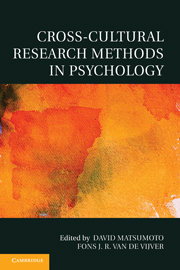Book contents
- Frontmatter
- Contents
- Contributors
- Cross-Cultural Research Methods in Psychology
- 1 Introduction to the Methodological Issues Associated With Cross-Cultural Research
- PART I Conceptual Issues and Design
- 2 Equivalence and Bias: A Review of Concepts, Models, and Data Analytic Procedures
- 3 Translating and Adapting Tests for Cross-Cultural Assessments
- Appendix Item Translation and Adaptation Review Form
- 4 Making Scientific Sense of Cultural Differences in Psychological Outcomes: Unpackaging the Magnum Mysterium
- 5 Sampling: The Selection of Cases for Culturally Comparative Psychological Research
- 6 Survey Response Styles Across Cultures
- Part II Data Analysis and Interpretation
- Name index
- Subject index
- References
2 - Equivalence and Bias: A Review of Concepts, Models, and Data Analytic Procedures
Published online by Cambridge University Press: 05 June 2012
- Frontmatter
- Contents
- Contributors
- Cross-Cultural Research Methods in Psychology
- 1 Introduction to the Methodological Issues Associated With Cross-Cultural Research
- PART I Conceptual Issues and Design
- 2 Equivalence and Bias: A Review of Concepts, Models, and Data Analytic Procedures
- 3 Translating and Adapting Tests for Cross-Cultural Assessments
- Appendix Item Translation and Adaptation Review Form
- 4 Making Scientific Sense of Cultural Differences in Psychological Outcomes: Unpackaging the Magnum Mysterium
- 5 Sampling: The Selection of Cases for Culturally Comparative Psychological Research
- 6 Survey Response Styles Across Cultures
- Part II Data Analysis and Interpretation
- Name index
- Subject index
- References
Summary
Introduction
This chapter addresses the methodological issues associated with equivalence and bias in cross-cultural research. These issues are a consequence of the nonexperimental nature of the research designs of cross-cultural studies. True experiments are based on the random assignment of participants to different experimental conditions, which presumably ensures that confounding variables are equated across experimental conditions. However, participants cannot be randomly assigned to cultures, and groups that are compared in cross-cultural studies can hardly ever be seen as matched on all background variables that are relevant for the constructs of interest. Cross-cultural psychology is not unique in the impossibility of matching groups; many studies in clinical and educational psychology involve situations in which intact groups are studied, and the assumption of the similarity of background characteristics across groups is unrealistic. The inability to conduct true experiments to address essential questions in cross-cultural psychology implies that we have to be careful in conducting our studies, being cognizant of relevant methodological knowledge and tools. It also implies that cross-cultural studies are always threatened by bias and inequivalence when cultural groups are being compared.
This chapter reviews the extant knowledge of these methodological issues. Our main message is that maximizing the validity of inferences should be the main concern of cross-cultural research and that methodological rigor in terms of establishing cross-cultural equivalence and suppressing bias across cultures plays a crucial role in this endeavor. We first describe a taxonomy of equivalence and bias, how they can be assessed, and the measures that can be taken to increase the validity of cross-cultural inferences. The second part gives an overview of procedures for adapting tests and survey questionnaires across cultures. Conclusions are presented in the final section.
Information
- Type
- Chapter
- Information
- Cross-Cultural Research Methods in Psychology , pp. 17 - 45Publisher: Cambridge University PressPrint publication year: 2010
References
Accessibility standard: Unknown
Why this information is here
This section outlines the accessibility features of this content - including support for screen readers, full keyboard navigation and high-contrast display options. This may not be relevant for you.Accessibility Information
- 38
- Cited by
